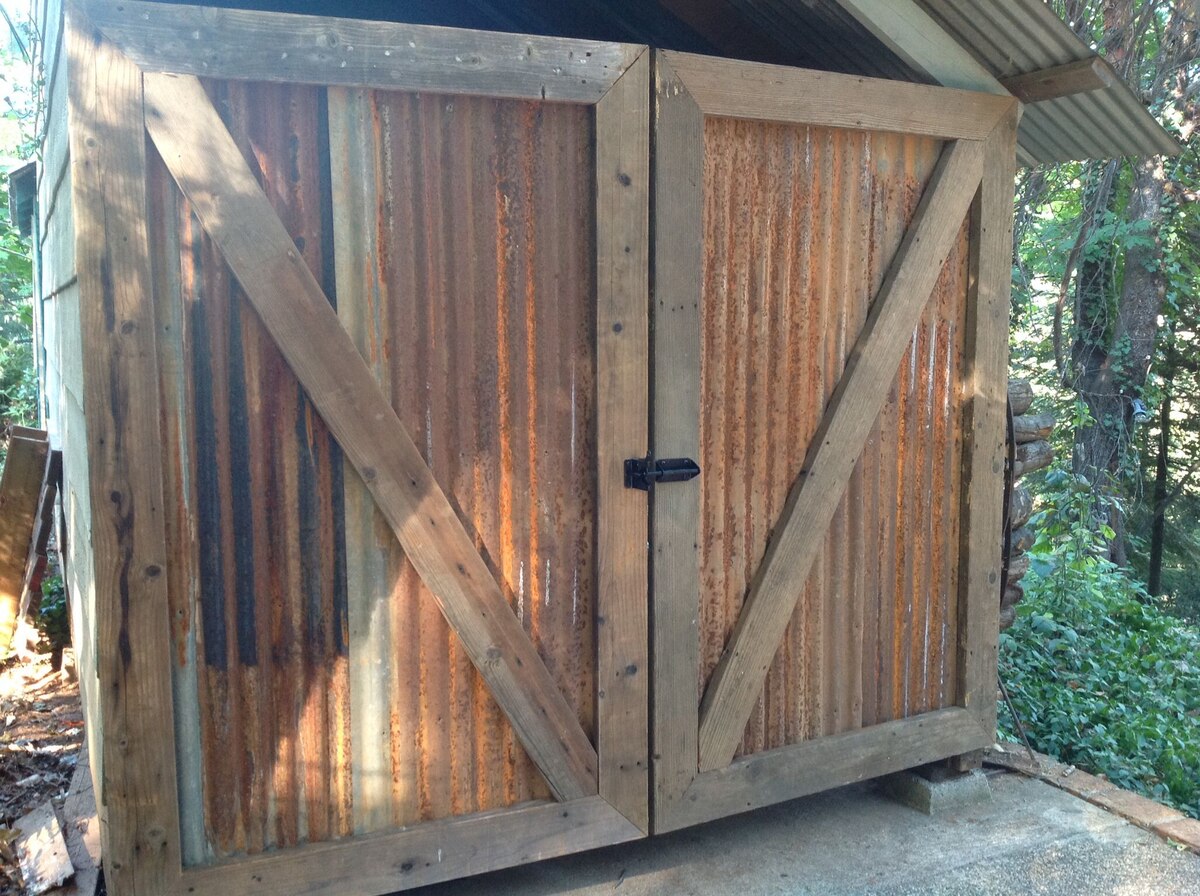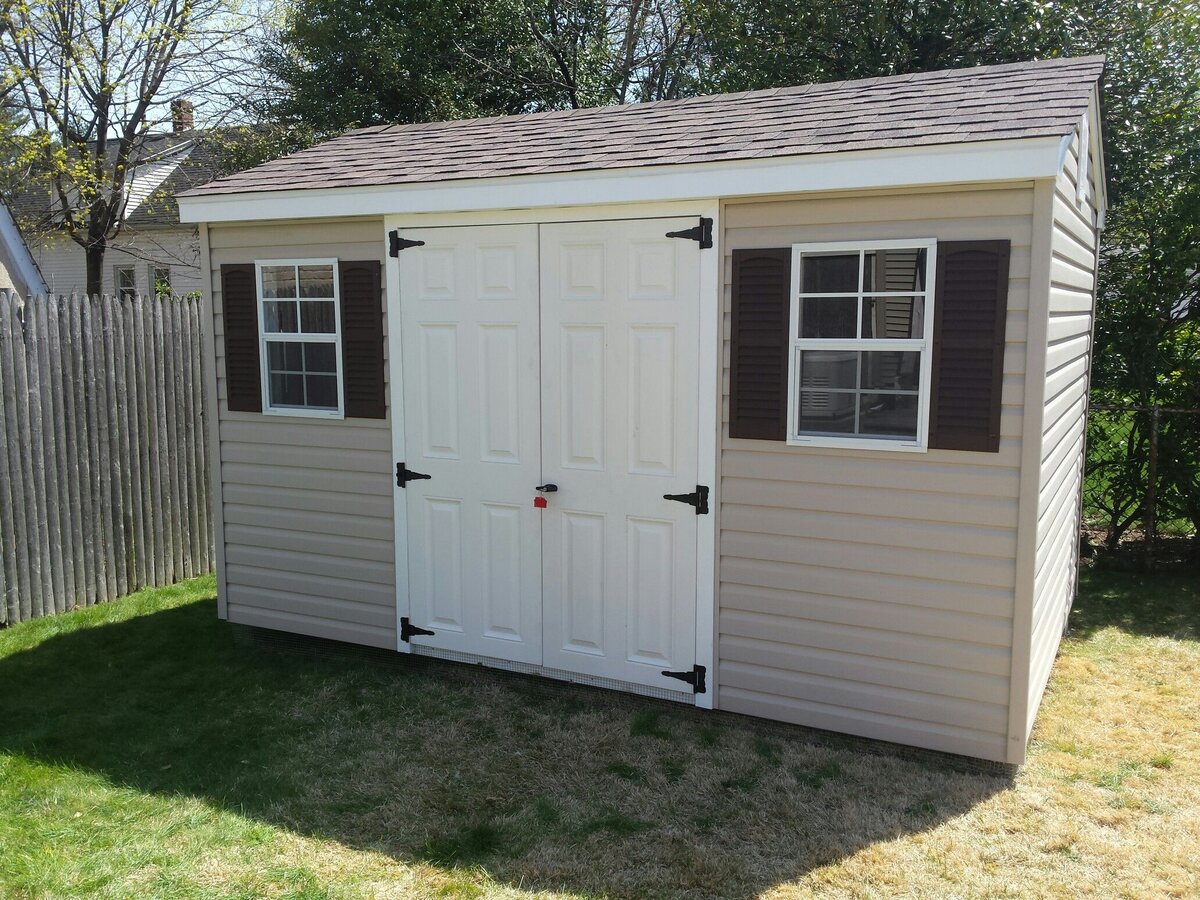Home>Gardening & Outdoor>Outdoor Structures>How To Fix Shed Doors


Outdoor Structures
How To Fix Shed Doors
Modified: August 20, 2024
Learn how to fix shed doors and keep your outdoor structures in top condition. Get expert tips and solutions for maintaining your shed.
(Many of the links in this article redirect to a specific reviewed product. Your purchase of these products through affiliate links helps to generate commission for Storables.com, at no extra cost. Learn more)
**
Introduction
**
Welcome to the comprehensive guide on fixing shed doors! Whether you have a wooden, metal, or plastic shed, dealing with a door that's not functioning properly can be a frustrating experience. However, with the right knowledge and a bit of elbow grease, you can restore your shed door to its former glory. In this guide, we'll walk you through the process of assessing the problem, gathering the necessary tools and materials, adjusting hinges and tracks, replacing or repairing hardware, and sealing and weatherproofing. By the end of this article, you'll be equipped with the expertise to tackle shed door issues with confidence. Let's dive in and get those shed doors back on track!
**
Key Takeaways:
- Don’t let a malfunctioning shed door ruin your outdoor storage experience. With the right tools and know-how, you can easily fix common issues like misaligned hinges and weather-related deterioration.
- Regular maintenance and proper sealing can prolong the lifespan of your shed door, keeping your stored items safe and secure from the elements. Embrace the opportunity to enhance your outdoor space with a well-maintained shed door.
Read more: How To Build Doors For A Shed
Assessing the Problem
**
Before diving into the repair process, it's crucial to assess the underlying issues affecting your shed door. Begin by carefully observing the door's behavior. Is it sticking, sagging, or misaligned? Are there visible signs of damage such as cracks, warping, or rust? Identifying these symptoms will help you pinpoint the root cause of the problem.
Next, examine the hinges, tracks, and hardware to check for any loose or damaged components. Loose screws, bent hinges, or worn-out rollers can all contribute to door malfunctions. Additionally, inspect the weather-stripping and seals for any wear and tear that may compromise the door's ability to keep out the elements.
It's also essential to consider environmental factors that could be impacting the door. Exposure to moisture, extreme temperatures, or direct sunlight can take a toll on shed doors over time, leading to deterioration and functional issues.
By conducting a thorough assessment, you'll gain valuable insights into the specific challenges your shed door is facing. This knowledge will guide your repair approach, ensuring that you address the underlying issues effectively.
**
Gathering the Necessary Tools and Materials
**
Once you've identified the issues affecting your shed door, it's time to gather the essential tools and materials for the repair process. Having the right equipment at your disposal will streamline the repair and ensure that you can address the problem effectively.
Here's a list of commonly needed tools and materials for fixing shed doors:
- Screwdriver set (Phillips and flat-head)
- Adjustable wrench
- Tape measure
- Level
- Hacksaw or reciprocating saw (for hardware replacement)
- Replacement hinges, rollers, or tracks (if necessary)
- Wood filler or epoxy (for repairing wooden door components)
- Sandpaper
- Paint or sealant (to finish wooden repairs)
- Weather-stripping and seals
- Lubricant or grease for hinges and tracks
- Protective gloves and eyewear
Before beginning the repair, ensure that you have a safe and well-lit workspace. Organize your tools and materials for easy access during the repair process. Additionally, if you're dealing with a particularly heavy or large shed door, consider enlisting the help of a friend or family member to assist with lifting and maneuvering the door as needed.
By preparing the necessary tools and materials in advance, you'll be ready to tackle the repair process efficiently and effectively, setting the stage for a successful shed door restoration.
**
Adjusting Hinges and Tracks
**
One of the most common issues that can affect shed doors is misaligned hinges and tracks. Over time, these components may shift or become loose, leading to difficulties in opening and closing the door smoothly. Fortunately, adjusting hinges and tracks is a straightforward process that can make a significant difference in the door’s functionality.
Begin by inspecting the hinges for any loose screws or misalignment. Using a screwdriver, tighten any loose screws to secure the hinges to the door and frame. If the hinges are severely bent or damaged, it may be necessary to replace them with new ones to ensure proper alignment and stability.
Next, focus on the tracks along which the shed door operates. Check for any debris or obstructions that may be impeding the door’s movement. Clear away any dirt or debris, and use a lubricant specifically designed for door tracks to ensure smooth gliding motion. If the tracks are visibly bent or damaged, consider replacing them to restore optimal functionality to the door.
After addressing any issues with the hinges and tracks, test the door’s movement to assess the improvements. It should open and close smoothly without sticking or binding. If adjustments have been made effectively, the door will operate with ease, providing seamless access to the contents of the shed.
Regular maintenance of hinges and tracks is key to preventing future issues with shed doors. Periodically inspect these components for signs of wear and tear, and address any issues promptly to keep the door functioning smoothly for years to come.
**
Ensure the door is properly aligned with the door frame and hinges are securely attached. Use a level to check for any unevenness and adjust as needed. Consider adding a latch or lock for added security.
Replacing or Repairing Hardware
**
When dealing with a malfunctioning shed door, the hardware components such as hinges, rollers, and latches play a crucial role in its operation. If these elements are worn out, damaged, or misaligned, they can significantly impact the door’s functionality. In some cases, repairing or replacing the hardware is necessary to restore the door to optimal working condition.
Inspect the hinges, rollers, and latches for signs of wear, rust, or damage. If the hinges are squeaky or stiff, applying lubricant can often resolve the issue. However, if the hinges are bent, cracked, or excessively worn, replacing them with new, sturdy hinges is the best course of action.
Similarly, rollers and tracks should be examined for wear and tear. If the rollers are worn or damaged, they can impede the smooth movement of the door along the tracks. Replacing worn-out rollers with new ones can vastly improve the door’s functionality. Additionally, ensure that the tracks are free of dents, bends, or obstructions that could hinder the door’s movement.
If the door features a latch or locking mechanism, check for proper alignment and operation. Over time, these components can become misaligned or stiff, making it difficult to secure the door effectively. Adjusting or replacing the latch hardware can enhance the door’s security and ease of use.
For wooden shed doors, any cracks, splits, or rot in the door panels should be addressed promptly. Using wood filler or epoxy, fill in any damaged areas and sand them down to create a smooth surface. Once the repairs are complete, consider applying a fresh coat of paint or sealant to protect the door from the elements.
By carefully assessing the condition of the hardware components and addressing any issues through repair or replacement, you can ensure that your shed door operates smoothly and securely, providing convenient access to your stored items.
**
Read more: How To Seal A Shed Door
Sealing and Weatherproofing
**
Effective sealing and weatherproofing are essential for preserving the integrity of your shed door and protecting its contents from the elements. Exposure to moisture, sunlight, and extreme temperatures can take a toll on the door over time, leading to deterioration and functional issues. By implementing proper sealing and weatherproofing measures, you can safeguard the door against these environmental factors and prolong its lifespan.
Begin by inspecting the weather-stripping and seals around the perimeter of the door. Over time, these components can become worn, cracked, or detached, compromising the door’s ability to keep out moisture and drafts. Replace any damaged weather-stripping with new, durable seals that provide a snug and effective barrier against the elements.
If your shed door is made of wood, it’s crucial to apply a protective sealant or paint to shield it from moisture and UV exposure. Choose a high-quality exterior-grade sealant or paint that is designed to withstand the rigors of outdoor conditions. Ensure that all surfaces of the door, including the edges and any exposed wood grain, are thoroughly coated to create a robust barrier against moisture infiltration.
Inspect the door for any gaps or cracks that may allow water or drafts to penetrate. Using a suitable sealant or caulk, fill in any gaps and cracks to create a watertight seal. Pay special attention to areas where the door meets the frame and threshold, as these junctures are common entry points for moisture and drafts.
Additionally, consider installing a drip cap or overhang above the door to provide added protection from rain and snow. A well-designed overhang can divert water away from the door, minimizing the risk of water damage and ensuring that the door remains dry and functional even during inclement weather.
By implementing comprehensive sealing and weatherproofing measures, you can fortify your shed door against the elements, preserving its structural integrity and ensuring that the contents of your shed remain safe and secure.
**
Conclusion
**
Congratulations on completing this guide to fixing shed doors! By following the steps outlined in this article, you’ve gained valuable insights into addressing common issues that can affect shed doors, from misaligned hinges to weather-related deterioration. Armed with this knowledge, you’re well-equipped to tackle shed door repairs with confidence and precision.
Remember, a well-maintained shed door not only enhances the functionality of your outdoor storage space but also protects its contents from the elements. Regular inspection and maintenance of your shed door will help prolong its lifespan and ensure that it continues to serve its purpose effectively.
As you embark on your shed door repair journey, keep in mind the importance of proactive maintenance. By addressing minor issues promptly and implementing proper sealing and weatherproofing measures, you can prevent more significant problems from arising in the future.
Lastly, don’t hesitate to seek assistance from professionals or knowledgeable individuals if you encounter complex issues or are unsure about the best course of action. Sometimes, a second opinion or expert guidance can make all the difference in achieving optimal results.
With your newfound expertise in fixing shed doors, you’re ready to take on the challenge and restore your shed door to its former functionality. Embrace the opportunity to enhance your outdoor space and create a secure and reliable storage environment for your belongings. Happy repairing!
Frequently Asked Questions about How To Fix Shed Doors
Was this page helpful?
At Storables.com, we guarantee accurate and reliable information. Our content, validated by Expert Board Contributors, is crafted following stringent Editorial Policies. We're committed to providing you with well-researched, expert-backed insights for all your informational needs.















0 thoughts on “How To Fix Shed Doors”